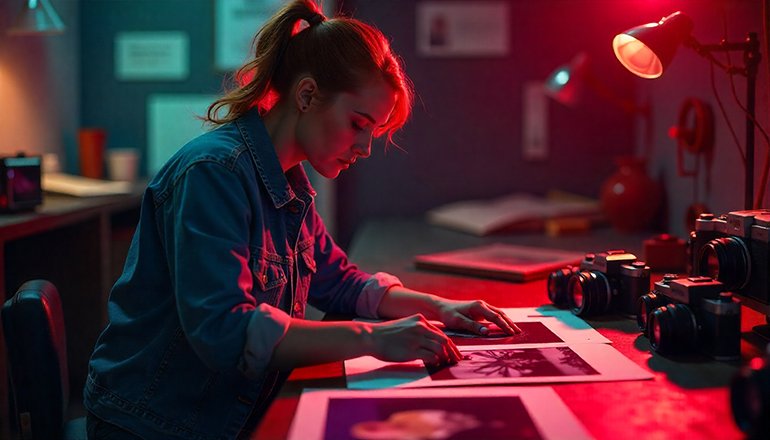
- comelyweb@gmail.com
- Printing Information
- August 25, 2025
- No Comments
Why Your Photos Deserve a Life Beyond the Screen
Introduction
How many photos are on your phone right now? A thousand? Five thousand? More? We live in an age of unparalleled photographic abundance. We capture sunsets, slices of birthday cake, and quiet morning coffees with the casual flick of our wrists. These moments are stored in digital vaults, often forgotten in an endless scroll, their pixels dimmed on a screen that also shows us the weather, our emails and the latest viral video.
There is a magic that happens when an image crosses the digital divide and becomes an object. It’s the weight of the paper, the subtle texture of the finish, the way light hits the ink. It’s a moment, frozen not in a cloud server but in your hand, on your wall, in your life. It’s not just nostalgia. It is about presence, permanence and the deep human connection we feel to tangible things. Welcome to the world of photo printing—a beautiful blend of timeless art and cutting-edge technology. Let’s rediscover it together.
Table of Contents
ToggleWhy print in a digital world? A case of solid memories
This is a fair question. Our phones are convenient, powerful and always with us. So why go through the “hassle” of printing?
Psychology
There is a significant psychological difference between seeing an image on a screen and holding it in your hands. Image is one. protest. It engages your senses more. You can touch it, put it in an album, or frame it. This ability creates a stronger, more emotional connection with the memory it represents. Studies show that photos can trigger more vivid and emotional memories than digital images. The screen is a temporary portal to countless things. A printed photo is a dedicated snapshot of a single, cherished moment.
The antidote to digital amnesia
How many of your digital photos have you looked at since the day you took them? Digital storage can feel like a black hole. We take photos with the best of intentions, but they often get lost in the digital clutter. Printing is a process of curation. This forces you to choose the best, most meaningful shots. This act of choice is, in itself, a way of honoring your memories. It turns a huge library into a curated gallery of your life’s highlights.
A legacy for the future
Think about your most treasured family heirlooms. Chances are, they’re things: a wedding ring, a handwritten letter, or a faded photo of your great-grandfather. Digital files are fragile. Hard drives fail, cloud services shut down, and formats become obsolete. A carefully printed photograph, especially on archival quality paper, can last for generations. It’s a straightforward, uncomplicated link to the past that doesn’t require passwords, electricity, or software updates to view.
From Pixels to Paper: Understanding Modern Printing Technologies
Gone are the days when printing meant a trip to a dingy, smelly darkroom or lonely kiosk in a drugstore. Today, the options are diverse and provide excellent quality. Let’s break down the main methods.
Inkjet Printing: Home Studio Hero
This is technology that most of us are familiar with. Home inkjet printers have become incredibly sophisticated.
- How it works: Tiny printheads move back and forth, spraying microscopic droplets of ink onto the paper. Quality is determined by the number of nozzles, the droplet (measured in picoliters) and the type of ink used.
- The Ink Revolution: The big leap forward came with pigment-based inks. Older dye-based inks were vibrant but could fade quickly when exposed to light. Modern pigment inks contain tiny particles of color that sit on top of the paper, resulting in prints that are more resistant to fading—often lasting 100+ years under glass.
- Best for: Hobbyists, families, and anyone who wants the convenience of printing at home. Perfect for everyday photos, school projects, and experimenting.
Dye-Sublimation (Dye-Sub): High speed specialist
Often used by online print services and in-store kiosks, dye is a fantastic technology for consistent, durable prints.
- How it works: A printhead heats a solid dye ribbon, turning the dye into a gas without first becoming a liquid (this is the “sublimation” part). This gas spreads over the surface of a special coated paper and then solidifies. The result is a print that is completely smooth, waterproof, and smudge-proof because the color inside Paper, not on top of it.
- Best for: High volume, continuous prints such as event photography (school photos, races), photo booth strips, and ID cards. Many home snapshot printers also use this technology for its durability and ease of use.
Laser Printing: The Workhorse (But Not for Photos)
It’s important to note that standard laser printers, which use toner powder and heat, are generally not ideal for high-quality photo printing. They are fantastic for text documents and graphics but often struggle with the subtle gradients and color depths required for true photographic reproduction.
The Great Debate: Printing at Home vs. Using a Professional Service
This is the central question for most people entering the world of printing. Both paths have their merits, and the best choice depends entirely on your needs.
The joy of printing at home
There is an undeniable satisfaction in snapping a photo with your camera within minutes.
- Advantages:
- Instant gratification: See a shot you like and you can print it before the moment cools down.
- Total Control: You can tweak colors, make test prints, and experiment with different papers and settings to your heart’s content.
- Convenience: No need to leave home or wait for shipping.
- Confidentiality: Your most personal photos never leave your possession.
- Disadvantages:
- Cost: It’s big. Printers are often sold cheaply, but ink is notoriously expensive. The cost per print at home is almost always higher than using a service.
- Trouble and Care: Printers can be faulty. Printheads fill up, drivers need updating, and you have to manage your paper and ink supplies.
- Learning curve: Achieving truly professional-looking results requires calibrating your monitor and understanding color profiles.
Convenience and quality of professional print services
From Shutterfly and Mpix to your local pharmacy or professional photo lab, these services do the heavy lifting for you.
- Advantages:
- High quality and consistency: Professional labs use industrial-grade, calibrated printers on pristine paper. You are almost guaranteed an excellent result without any technical knowledge.
- Low cost per print: For standard size prints, especially in large quantities, the services are far more economical.
- Main type: Want a metal print, canvas wrap, acrylic face mount, or photo book? The services offer an incredible array of products that you could never make at home.
- No problem: Upload, order and wait for beautiful prints to arrive at your doorstep.
- Disadvantages:
- Waiting time: You lose the instant gratification factor.
- Less control: While you can usually make basic adjustments online, you don’t have control over the home setup.
- Shipping costs: This can add up, though many services offer free shipping on larger orders.
Verdict: If you print frequently and love the process, a quality home inkjet is a wonderful investment. For most people, especially those who want to print in large quantities or create special products, a professional service is the most cost-effective and quality-wise choice.
More than just shiny: the world of papers and finishes
The paper you choose isn’t just the canvas. It is an essential part of the artistic expression of your image.
- Shiny: Classic finish. It offers vibrant colors, deep blacks, and a sharp, reflective surface. It’s great for making colors “pop” but can be prone to fingerprints and glare under glass.
- Fade: A non-reflective, beautiful finish. It has a soft texture, is resistant to fingerprints, and is perfect for black and white photography or portraits where you want to avoid any glare. It feels artistic and timeless.
- Glitter/Pearl/Silk: It’s a wonderful middle ground. It has a slight sheen but no glare, offering bright color vibrancy with matte fingerprint resistance. It’s a professional favorite for a reason—it looks good on almost everything.
- Metallic: These papers have a pearlescent coating that gives incredible light and depth to the prints. Colors look more vibrant, and whites look brighter. It’s a modern, dramatic finish that works wonderfully for landscapes, cityscapes, and abstract images.
- Fine Art Papers: Made from cotton rags instead of wood pulp, these papers are acid-free and designed to last for centuries. They have beautiful textures—like watercolor paper—and are a choice for gallery-quality prints and heirloom portraits.
Protecting Your Legacy: How to Care for Your Prints
You have invested in beautiful prints. Now make sure they are last.
- Frame with UV protective glass: The number one enemy of prints is sunlight. UV glass filters out harmful rays that cause fading. This is absolutely necessary for the print you plan to display.
- Take care of the environment: Keep prints away from high humidity (bathrooms, basements), extreme heat and direct heat sources such as radiators.
- Handle with care: Hold the prints by the edges. Oils from your fingers can degrade paper and ink over time.
- Use archive content: If you are putting prints in an album or box, make sure the material is acid-free and lignin-free. Regular cardboard and plastic page sleeves can yellow and damage photos over time.
- Store properly: For prints you’re not displaying, store them in quality storage boxes or sleeves in a dark, cool, dry place.
Frequently Asked Questions (FAQ)
Q: What is the best resolution to print a photo?
A: A good rule of thumb for desired print size is 300 pixels per inch (PPI). So, to print a sharp 4×6 inch photo, your image file should be at least 1200 x 1800 pixels. Most modern smartphone cameras are more than capable of this.
Question: My home printer’s colors never match my screen! Why?
A: This is one of the biggest challenges. Monitors emit light (RGB color mode), while printers use ink to reflect light (CMYK color mode). Here is the solution. Calibration. Using a hardware calibrator for your monitor ensures that it displays colors accurately, allowing you to make adjustments with confidence that your printer matches your vision.
Q: Are printed photos really a better way to preserve memories than digital backups?
A: They serve different purposes. The best strategy is a hybrid approach. Use the “3-2-1 rule” for your digital origin: 3 copies of your data in total, 2 on different media (eg, hard drive + cloud), 1 copy stored offsite. Then, print out your absolute favorites. That way, you have both a secure digital archive and a priceless physical legacy.
Q: How long will my printed photos last?
A: An inexpensive home printer with dye-based ink can run out of print in a few years. A print from a professional service using pigment ink on archival paper, properly stored, can last 100+ years without significant fading. If longevity is your goal, always look for “archival” or “museum quality” claims.
Q: What is the easiest way to start printing my photos?
A: Don’t overcomplicate it! Start simple. Pick your 10 favorite photos from the past year. Upload them to a reputable online print service (like Mpix, Shutterfly, or even your local pharmacy) and order them in a standard 4×6″ or 5×7″ size on glossy paper. Hold them in your hand. Keep them in a simple album. See how it feels. You may just be hooked.
The result
In our relentless rush into the digital future, we risk losing something fundamental: proof of our lives. Photo printing technology is not obsolete. It is the perfect marriage of modern innovation and eternal human desire. It is the technology that allows us to hold a moment, give weight to a memory, and create a concrete history for ourselves and those who come after us.
So, take a break from endless scrolling. Dive into your camera roll. Find that photo of your child’s uncontrollable laughter, the serene serenity of a mountain vista, or the collective smiles of a family reunion. Order a print. Frame it. Keep it on your desk. Give it to someone you love.
Turn your pixels into valuable items. Because the picture isn’t complete until it’s off the screen.





